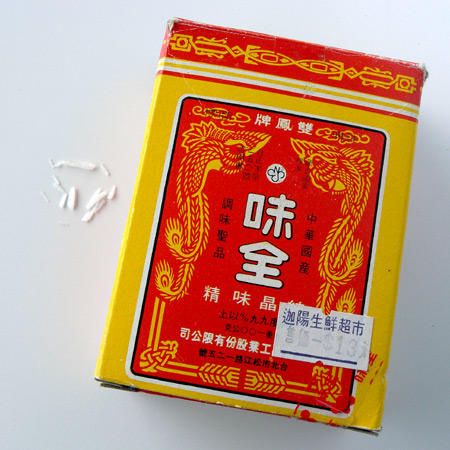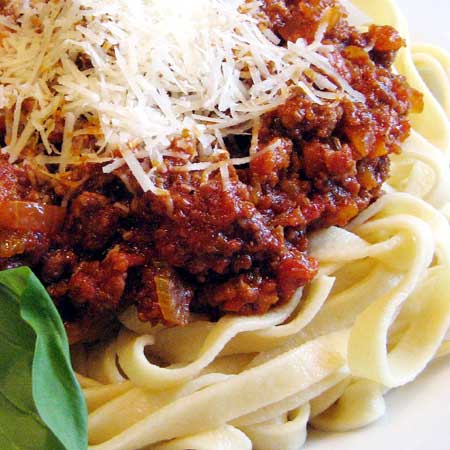
Pure mono sodium glutamate from Taiwan
A recent article (found via Harold McGee’s News for curious cooks) featuring Heston Blumenthal as a co-author emphasizes the huge difference in glutamic acid contents between the flesh and pulp of tomatoes. Glutamic acid and it’s sodium salt (mono sodium glutamate or MSG) are responsible for the characteristic umami taste. On average the flesh contains 1.26 g/kg glutamic acid whereas the pulp on average contains 4.56 g/kg glutamic acid. Similar differences are found for several nucleotides which posess similar taste qualities. These differences can explain the perceived difference in umami taste between the flesh and pulp of tomatoes – and is worthwhile considering when cooking.
Those concerned about food with added MSG should read the chapter about MSG in John Emsley’s excellent book “Was it something you ate?”. First thing to note is that you can’t be allergic to MSG because our body needs glutamic acid to function properly. Emsley retraces the history of the Chinese restaurant syndrome (CRS) back to it’s roots in 1968 when a letter was published (R.H.M. Kwok, New Engl. J. Med. 1968, 278, 796) describing a series of symptoms experienced after having eaten at a Chinese restaurant. To make a long story short, in 1993 Tarasoff and Kelly reviewed previous studies and conducted a double blind test which led to the following conclusion:
… ‘Chinese Restaurant Syndrome’ is an anecdote applied to a variety of postprandial illnesses; rigorous and realistic scientific evidence linking the syndrome to MSG could not be found.
Following the publication, a critical reply was published by Adrianne Samuels, to which the authors have replied.
Anyway, it was in John Emsley’s book that I first read about the record levels of glutamic acid found in parmesan cheese: 12 g/kg! That’s nearly three times the amount found in tomato pulp. In some cheeses there is so much that it crystallises out in small white crystals visible to the naked eye. Think about this when you sprinkle your food with parmesan. And if you ever wondered why Italian food tastes so nice, now you know that MSG is one reason (but of course not the only one …).


There is a certain restaurant that every time I go there I get a tingling sensation on my skin. It happens a few minutes after I start eating. I know MSG is safe to consume and that studies have found no permanent effects. I even have a jar I use occasionally. But at that restaurant …
A group of experts recently met to review the food safety of MSG and concluded that on average an european consumes 10g/day of protein bound glutamate, 1g/day of free glutamate and 0.4g/day as part of added seasoning. This is way below the 16g/kg-of-body-mass/day that is considered safe to consume. They also concluded that the BBB(Blood-brain barrier), if healthy, is sufficient protection for the brain against excitotoxic damage. These are consensus conclusion come to by a review of the scientific literature by well cited and well regarded scientists. (They also appear well funded.)
The consensus review was published in the European Journal of Clinical Nutrition (2007) 61, 304–313. dx.doi.org/10.1038/sj.ejcn.1602526 .
It is funny to have a look to a list of glutamate containing foods. By the way, Iberian dry cured ham is nearly 10g/Kg. Nevertheless, it should be considered that some of these amounts are provided as dry matter while other don’t.
By the way, I am almost sure that the crystals in long aged cheeses (as well as in long aged meats, such as ham) are not composed by glutamic acid, but by tyrosine, which also comes from proteolysis due to endogenous (mainly) proteases, and which is quite insoluble. Therefore, once released from proteins, it precipitates in the moment the moisture content decreases. In hams, there is sometimes a white film on the surface (especially in cheap sliced ones) also mainly composed by tyrosine.
De verdad que estas informaciones me escandalizan. El rotaval es una rotavapor, que es una aparato de laboratorio que se utiliza desde hace muchos muchos años. De hecho, la versión para laboratorios de exactamente el mismo aparato que venden como “rotaval” cuesta más o menos la mitad (y ya es casi un robo). Algo similar a lo que ocurre con la “roner”, la “tanita” y robos a mano armada por el estilo.
Ni Alicia ni Joan Roca han desarrollado nada en el ámbito de los destilados con rotavapor (me extrañaría mucho que supieran lo que es una plato teórico, por ejemplo), solamente sus aplicaciones para obtener destilados de uso culinario (para destilar cualquier otro tipo de producto se lleva usando muchos años).
Sorry, last comment was aimed for another blog (copy-paste problems).
When I first moved to South America I was fascinated to see the amount of MSG consumed and used in cuisines throughout the continent – it’s used as a “flavor enhancer” by virtually every cuisine here. At the same time, people complain of the exact same thing in Chinese restaurants “oh, I can’t have any MSG”, while meanwhile they probably have a jar of the stuff sitting in their own pantry, under the locally used name of “ahi-no-moto”, and have no idea that they’re using the same stuff.
Papin: Thanks! I was not aware of that paper!
Orges: Yes, according to McGee it is tyrosine that precipitates out, so you’re absolutely right about that!
I thought the crunchy crystals forming on some hard cheeses were actually calcium phosphate – there is lots of phosphotyrosines in the chain, mostly in the form of Ca salt, chymosine precipitates the casein by cleaving the phosphates etc. (It would be quite easy to figure out whether the mysterious crystals are inorganic stuff.)
Assaying the glutamate content was used as a reliable method to estimate the age of parmasan (the aged stuff is more expensive)
I’ve long thought that for many people “I’m allergic” is just another way of saying “I’m a picky eater” – so it’s great that science is proving this to be the case. Teach your children well – don’t force them to eat what they don’t like, but get them to try a tiny taste EVERY TIME you serve something (“your tastebuds change” is the mantra in this house). That way they’re exposed to new tastes, even if they don’t yet want to embrace them.
Joanna
joannasfood.blogspot.com
Jeffrey Steingarten (on MSG): Why Doesn’t Everybody in China Have a Headache? in It Must’ve Been Someting I Ate, ISBN 0375727124
If someone tells me there is MSG in such a food, I prefer not to eat it. Other than that, there is no way we can avoid MSG in the food we eat today. Whatever we eat, “this baby” is always there.
Well, people get sick for hating and gossiping while trying to enjoy the most delicious foods; then, they blame the MSG. However, I think that millions of people are bad for the food they consume. These people are miserable no matter what they eat. For them, even mineral water is poison.
Hatred and evil thoughts while digesting might make more sick people than MSG does.
I’ve been going to Asia for many years and never; thank God, got sick. I may consider myself a 52-year healthy male. Moreover, I never blame what I eat, because I am always thinking about people who are so poor and have no food choice.
Everything in excess is a problem.
[…] (savory) with high percentages of glutamic acid. Glutamic acid is MSG. Contrary to popular opinion it is wrong that MSG is bad for you. After all, our own body produces glutamic acid, a simple amino […]
Has anyone ever tried adding disodium guanylate and/or disodium inosinate along with MSG to something home-cooked?
I’ve been wondering what effect that would have. They add these ingredients to potato chips; I wonder how much of a difference they make.
Also – regarding monosodium glutamate:
While there’s no evidence that MSG is bad for you, the urban legend persists, and to get around putting “monosodium glutamate” on their ingredient labels, food companies put “hydrolyzed soy protein” instead. Since glutamate is an amino acid, the effect of adding hydrolyzed soy protein is essentially the same as adding MSG, while technically no MSG has been added.
There is a major flaw with the double blind studies in that to do a double blind study, they have to bypass the taste sensation and deliver it via pills. How do they know that the stimulation of the nerves involved in taste or buccal absorption wouldn’t be involved in the mechanism behind “Chinese Restaurant Syndrome”? By delivering the MSG in pill form in the studies, they assume that it does not. What if the mechanism involved taste or absorption through the mouth? Then the studies would have been designed to eliminate the existence of precisely what they were trying to study.
Food for thought: the eating of another flavoring, spicy hot chili pepper, causes some people to have the physiological reaction of sweating, but what would happen if you have them eat the pepper in pill form? One might conclude from such a double blind study that eating hot chili pepper doesn’t make people sweat any more than the placebo controls did.
Also, how do we know that the sodium doesn’t play a role thus making MSG not exactly the same as glutamic acid?
Claire: That’s an interesting objection and I agree that with chili peppers a test with chili capsules would not give the same “hot” felling in the mouth. If this could be the case with MSG is way beyond my expertise. But at least Tarasoff and Kelly have ruled out the possibility that MSG taken up through the gut will cause the CRS.
My typical control question if people claim to experience the CRS is if the same thing occurs when they eat tomatoes or parmesan…
Regarding sodium – remember that MSG and GA will be in equilibrium depending on the pH in the food, in the mouth and in all of your intestines. Although it’s typically added in the form of a salt some of it will be converted to GA when eaten.
I become violently thirsty in the night if I eat certain foods for dinner. I thought it was common salt, but it is worse if I have tomato paste, and last week I had parmesan for the first time in years, and it was the same. I get a bit thirsty in the evening and drink plenty, then wake in the night with dry mouth and sometimes a dehydration headache and busting for a pee. Last week after the parmesan the headache persisted until morning even though I drank 500ml water during the night, and I was very thirsty and drank a lot the whole of the next day. I’m assuming it was the MSG in the foods.
BTW, a stock that my mum uses that has disodium iosinate in it does a similar thing.